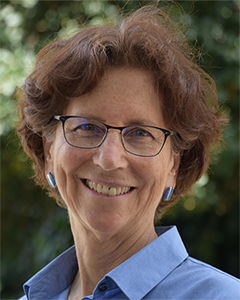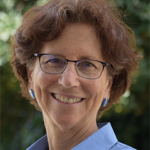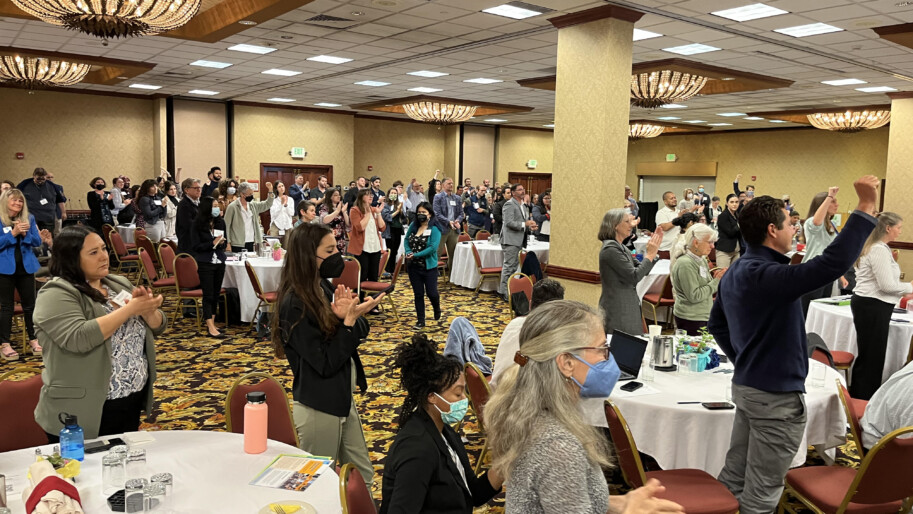Welcome to the 2023 California Climate Policy Summit!
Thank you for being here today. It is inspiring to see so many climate activists and leaders from across the state — from environmental and environmental justice organizations, from local government, from the faith and healthcare communities, from business and labor — welcome! Thank you for being here to ensure we enact the bold policies needed to secure a livable future for all.
The new United Nations climate science report shares what we’ve known for some time: climate change is getting worse, it’s deadly, and it’s caused by burning fossil fuels.
UN Secretary-General António Guterres said after the release of the IPCC Sixth Assessment that the report “is a clarion call to massively fast-track climate efforts by every country and every sector and on every timeframe.” He said that our world needs climate action on all fronts: everything, everywhere, all at once.
Even the very conservative International Energy Agency says we cannot build any new oil, gas, or coal infrastructure.
Yet emissions were the highest ever globally in 2022. Even with everything we know:
- The United States is number one in the world with plans for more oil and gas, including fracking.
- California permitted more than 900 new or reworked oil and gas wells since January and almost 600 of those are within the health and safety zones we passed into law last year, which are now suspended, thanks to Big Oil and its lies.
- Let me say it again: almost 600 new or reworked oil and gas wells have been permitted near kids and schools since January.
This is unacceptable.
The good news is that we have the solutions. We know what we need to do. We know how to achieve equitable, accelerated climate action. We just need the political will!
We know that investing big time now and cutting fossil fuel pollution saves lives and dollars.
Fortunately, there are now positive tipping points:
- Solar is the cheapest form of electricity globally.
- Renewables provided more power than coal in the United States for the first time in 2022.
- Building new solar and wind is cheaper than operating fossil fuel plants.
- The City and County of Los Angeles as well as Culver City are phasing out oil and gas wells.
- The San Francisco Bay Area Air Quality Management District just banned new replacement gas furnaces and water heaters (but not stoves — yet).
- 75 cities in California require all-electric new buildings.
- Sonoma County has even banned new gas stations in unincorporated areas.
It’s happening, but we still have to do much more, much sooner. Every bit more of warming matters, so every step we can take to reduce it is huge.
The prescription from the 2018 1.5 degrees Celsius report still holds–and as bold as it is, we probably must do even more: cut emissions in half by 2030 and draw down past climate pollution to have a chance at securing a stable climate.
That means we in California must enact bold, ambitious policies and actually implement them in ways that do not cause further harm to our frontline, working-class communities already bearing the brunt of fossil fuel pollution and climate change.
Bold goals work, as we have seen again and again. As goes California, so goes the world. We can demonstrate how to move forward at the speed and scale required — and we can do it equitably.
The Climate Center is proud to be sponsoring SB 12, a bill authored by Senator Henry Stern to increase the state’s emissions reduction target from 40 percent to at least 55 percent by 2030. A similar bill almost passed last August, but lost by a handful of votes. It was the only one of the governor’s legislative climate priorities that didn’t pass. The United Kingdom has a goal of 68 percent and the European Union has a goal of 62 percent cuts by 2030. They are showing the world what is possible. Solar and wind power generated one-fifth of Europe’s electricity in 2022, more power than fossil gas for the first time.
For the world to get near to what the United Nations scientists are telling us is needed, California needs to lead with more ambitious policies, unleashing innovation, sending those market signals to bring in much more private sector investment and make climate solutions affordable for everyone. 2045 is simply too late for carbon neutrality.
And there are so many benefits to equitably accelerating emissions reductions.
A report by E3 shows that California could save $44 billion and prevent nearly 5,000 deaths every year from fossil fuel pollution by rapidly phasing out oil and gas use in buildings and transportation. Energy Innovation found that achieving a 55 percent reduction in climate pollution by 2030 would create millions of jobs in the coming decades. By 2030, it would create more than 235,000 additional jobs, including more than 59,000 in the manufacturing and construction sectors, and increase California’s GDP by $55.4 billion.
In fact, we should be legislating even larger cuts. The Climate Center — using the Energy Innovations Energy Simulator tool — found we could achieve 65 percent cuts by 2030, creating 300,000 new jobs and saving almost 2,500 lives per year.
We should be stopping fossil fuels, rapidly transitioning to renewables — including much more distributed energy — and doing it in ways that improve air and water quality in frontline communities. We know how to do it! We need both to establish targets aligned with the science and to implement at speed and scale.
This legislative session, there are bills to do both in addition to SB 12.
I want to highlight a few out of the many bills I hope everyone will actively support:
- Senator Nancy Skinner’s bill, SB 233, which is sponsored by The Climate Center, requires virtually all new EVs sold in California to be capable of bidirectional charging by 2027, which will help to keep the power on as we face more and more extreme events. In fact, my Nissan Leaf, which is out in the parking lot today so you can see how this works, was one of 40,000 cars in California last September whose battery capacity was not used to help get through the major heat wave. But the potential is huge! Last fall, during an extreme heatwave in which we narrowly averted blackouts, California had more than 1 million EVs sitting in driveways, in school bus yards, and in city parking lots — untapped — that could have provided almost 10 GW if fully charged. That’s about one-fifth of the total power needed.
- Senator Scott Wiener’s Corporate Climate Accountability bill, SB 253 — co-sponsored by California Environmental Voters, the Greenlining Institute, CERES, Carbon Accountable, and Sunrise Bay Area — requires businesses that bring in $1 billion or more in revenue and that operate in California to disclose their greenhouse gas emissions annually to hold them accountable.
- Senator Lena Gonzalez’s bill, SB 556 would establish health protection zones where oil and gas production facilities or wells are located within 3,200 feet of schools, health centers, and homes. It would make the operators or owners of these liable for respiratory ailments, pre-term births or high-risk pregnancies, and a person’s cancer diagnosis. Isn’t this how it should be? Thank you, Senator Gonzalez!
- Another bill authored by Senator Gonzalez, SB 252, would require CalPERS and CALSTRS to divest from fossil fuels.
- Senator Josh Becker’s bill SB 49 would provide tax breaks for solar parking lot canopies.
- Assemblymember Eloise Gomez Reyes’s bills, AB 1000, would prohibit large warehouses within 1000 feet of homes, schools, and health centers to reduce diesel and noise pollution in primarily frontline communities.
Today, you will have the opportunity to learn more about these and many other great pieces of legislation worthy of your active support, as well as some we should all oppose! We also have panels on policy and climate health impacts, the appropriate role for green hydrogen, and how we could reform California’s cap and trade program.
It will be a great day together.
But let’s remember: There are always wins and there are always losses. We know we have to keep at it, never give up, and keep doing the hard work. We see what’s happening around the country. Racism and fascism are on display in places like Tennessee, shutting down those speaking for democracy and environmental justice.
We here in California must show what real participatory democracy means for our collective future. It means working together in unprecedented partnerships.
We know we can only achieve a carbon-negative and equity-positive future by working together. Together, we can overcome the insidious influence of Big Oil and Big Utilities on California’s policymaking. Working together, we amplify our power. That’s what this Summit is really about.
- We can dramatically cut polluting emissions.
- We can start the phaseout of fossil fuels.
- We can vastly increase the deployment of solar and wind, including local-scale solar and storage.
- We can ensure clean water and air, improved health, and access for everyone to clean energy solutions.
- And we can work with nature to draw down past climate pollution while also enhancing biodiversity, food and water security, and resilience to increasing extremes.
There is no other option. Working together, we must and will secure a healthy, climate-safe future for all!


